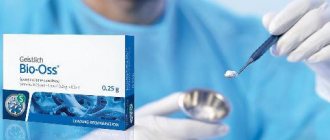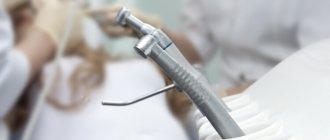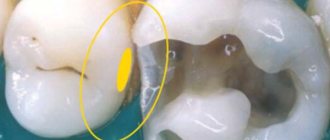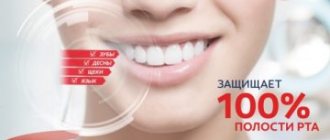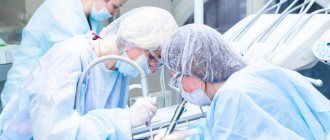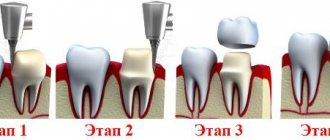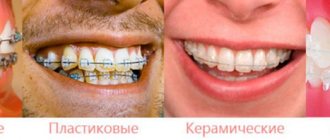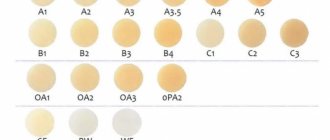8058
Discomfort in the cervical spine, headaches, snoring, tinnitus - this is not the entire list of symptoms that can be caused by malocclusion.
While the solution to these problems is carried out in the dentist's chair, by installing an orthotic, many patients seek salvation in the offices of other various specialists.
A special design, included in the list of neuromuscular dentistry techniques, makes it possible to influence not only the aesthetics of a smile, but also save the patient from certain diseases of the body.
A little about neuromuscular dentistry
Neuromuscular or, as it is also called, functional dentistry (NMS) is a whole science that studies malfunctions in the joints and muscles of the dental system. Based on the diagnostic results, industry experts suggest ways to solve the identified problem.
Under a malocclusion we are accustomed to accept the pathological arrangement of teeth. However, a certain violation of the aesthetics of the smile is the last consequence of improper interaction of the jaws.
Modern orthodontists offer to eliminate pathology by wearing various braces.
However, this treatment for malocclusion is incomplete, since disturbances in the functioning of the muscles and joints of the maxillofacial apparatus will not be corrected.
On the contrary, in some cases, artificially created pressure will aggravate the situation and the symptoms of the pathology described above.
Neuromuscular dentistry sets itself more global goals. CMS specialists care not only about the high level of aesthetics of the smile, but also about normalizing the relationship between the dentition, by restoring the proper functionality of the joints and muscles.
In European countries, this industry has existed for many years, but in our country there are still very few qualified NMS professionals.
But, according to experts, many orthodontists will adhere to the principles of work of neuromuscular dentistry specialists in the near future.
Additional information about functional occlusion is presented in the video.
The role of the masticatory muscles
The muscles that hold the lower jaw take part in the process of chewing food. They are responsible for raising and lowering it. The joint on which the teeth of the lower row are localized is called the temporomandibular joint (TMJ).
During food processing, muscles produce the necessary amount of energy for this process. If there is too much of it, they relax and return to their original position.
If a person has an incorrect bite, they cannot fully take the starting position. As a result, muscle spasm occurs, and as a result, limited movement of the TMJ.
The functionality of the masticatory muscles can be compared to working out in the gym. When you push yourself to the limit, the next day you find it difficult to move around.
During the continuous process of chewing food, the muscles become clogged with waste, and the jaw cannot open fully. This disorder leads to tooth wear.
What are the causes of malocclusion?
As a rule, malocclusions originate from childhood.
- Mouth breathing instead of nasal breathing;
- Severe injury;
- Increased tooth wear or grinding;
- Incorrectly installed filling or prosthesis;
- Displacement during teething.
All this gradually leads to TMD - dysfunction of the temporomandibular joint. The joint, which provides movement and connection of the upper and lower jaws, contributes to the proper development of chewing and speech functions.
Occlusal splint device
An orthotic is a transparent mouthguard, in most cases removable, and made of plastic, which is placed on one of the jaws of the oral cavity.
Another name for the design is an occlusal splint. Its placement depends on the specialist’s tasks. The severity of the pathological bite affects whether a removable or fixed orthotic will be installed.
The latter provide stationary fixation of teeth and regulate all occlusal functional loads. Their use does not interfere with speech and normalizes the chewing process.
However, to install them it is necessary to prepare the teeth. In addition, the design significantly worsens the hygienic condition of the oral cavity.
Depending on the design features and functional purpose, orthotics are divided into types:
- relaxation – provide a decrease in muscle tone and centralize the localization of the articular heads;
- decompression - used in the treatment of compression in the upper or posterior parts of the TMJ;
- stabilizing – create contacts between all teeth of the lower and upper dentition;
- positioning – change the pathological position of the teeth;
- repanning – return the dentition to its original position.
Patients should understand that the mouth guard is far from a prosthesis and causes slight discomfort when worn.
Functional and radiation diagnostic methods in orthodontics to identify anomalies of the dentofacial system.
Let's find out here whether macrodentia is an anomaly.
At this address https://orto-info.ru/zubocheliustnye-anomalii/zubov/formyi/konicheskie-i-shilovidnye.html you will learn how to correct awl-shaped teeth.
Manufacturing
For the production of both removable and non-removable structures, hypoallergenic plastic is used, which is soft and elastic. The product is modeled to suit the individual characteristics of each patient’s dentition.
For this purpose, an X-ray examination (panoramic image) and computed tomography are prescribed, which allows you to assess the condition of the muscles and ligaments of the masticatory apparatus.
In addition, the correct physiological bite is studied by relaxing the muscles using a special device - a myomonitor.
First, the specialist makes an impression of the lower jaw, which is sent to the laboratory. Then a computer simulation of the jaws and the future structure is carried out based on the cast and panoramic X-ray.
When making a structure, a number of factors are taken into account:
- therapy plan;
- duration of treatment;
- product rigidity;
- design features that allow installation without creating tension in the oral cavity.
In addition, a plastic mouth guard should not injure the enamel or irritate the mucous membrane, or create hygiene difficulties.
What is dental enamel dysplasia and what methods are used to eliminate such anomalies in the structure of hard tissues?
In this publication we will talk about dental microdentia.
Follow the link https://orto-info.ru/sistemyi-vyiravnivaniya-zubov/lechebno-profilakticheskie-apparatyi/ortodonticheskie-treyneryi.html if you are interested in reviews about the orthodontic trainer.
Restorative therapy
To eliminate pathological abrasion of hard dental tissues, it is necessary to carry out treatment in three directions. To begin with, provoking factors are eliminated, after which the missing bone volumes are restored and the interdental relationship is normalized. Minor manifestations of pathology are eliminated by wearing night guards. The chewing muscles relax and tooth friction is eliminated.
Before starting all procedures, it is necessary to make a diagnosis. To make an accurate diagnosis, the Implantmaster clinic has technology (images are more accurate, and X-ray radiation is even less), the ability to take a panoramic image of all teeth and targeted radiography of a specific unit.
In severe cases of erasure, the following methods are used:
- Placement of crowns. It would be optimal to install metal-ceramic crowns for molars, which restore the natural shape of the crown and restore functionality when chewing. Installation of all-ceramic crowns made of zirconium dioxide is recommended for the front teeth.
- Stump inlays are used in case of large destruction of the crown part of the tooth. They accurately follow the shape of the root canals and give the tooth a margin of safety.
- Microprosthetics with veneers. Such prosthetics will protect not only from pathological abrasion, but also provide an aesthetically pleasing smile.
Wearing
In general, experts recommend using an orthotic for several months. During this period, the structure prepares the muscles and joints for orthodontic systems or for restoration of dentition.
During the period of use of the orthotic, the symptoms of TMJ dysfunction weaken and almost completely disappear.
Wearing non-removable products is prescribed for the main treatment method in cases of serious impairment of neuromuscular functionality.
It is worth noting that the effectiveness of the structure’s operation is observed due to a reduction in the load on the mandibular joint and, accordingly, constant muscle relaxation.
When wearing the product, you must follow certain rules:
- The orthotic should be worn constantly, especially not removing the device from the oral cavity at night . The teeth of the lower and upper jaws must be in constant contact. At night, we involuntarily squeeze them when swallowing.
- You should not remove your orthosis before visiting the dentist. The structure should be in the mouth for half an hour at the time of sitting in the chair. This is exactly how much time is needed for the heads of the joint to take the correct specified position.
- Intentional pressure on the splint is not necessary if there is only a small amount of space between the teeth.
- The design must be present at every visit to a specialist.
- When removed, the product must be stored in a closed container filled with an antiseptic solution. This rule is very important, as this way you maintain the softness of the plastic.
- During hygiene procedures, it is necessary to brush not only your teeth, but also your orthotics. All you need is a regular brush and paste.
- Don’t forget to visit your dentist to correct the surface of the structure. Depending on the progress of treatment, the specialist may sand or layer the plastic.
It is necessary to follow the rules even if you do not observe significant changes.
Efficiency
The effectiveness of treatment is indicated if all the planned changes while wearing the orthotic have been achieved. An important role in this issue is played by the extent to which the neuromuscular system tolerates the presence of a foreign body in the mouth.
If the implementation of the plan requires a long service life of the structure, the presence of a foreign body in the oral cavity can provoke a number of diseases - periodontal pathology, loosening of teeth, numerous caries, TMJ dysfunction.
However, in most cases, wearing an orthotic:
- normalizes the functionality of the mandibular joint;
- reduces or completely eliminates muscle pain;
- ensures a healthy position of the lower jaw;
- modifies the trajectory of the joint during chewing;
- reduces the degree of enamel abrasion during bruxism;
- improves the condition of the oral cavity before installing braces or complete dentures.
Cost of treatment for TMJ dysfunction
Answering questions frequently asked by patients: “How much does treatment for TMJ dysfunction cost, with a discount, at a promotion? Where and how much cheaper are the prices for such turnkey treatment, in Moscow, St. Petersburg or other cities of Russia?”, it should be noted that the price of treatment for pathology and dysfunction of the TMJ jaw joints and the cost of its individual stages depends on the following points:
The cost of diagnosing TMJ dysfunction starts from 10,000 rubles and can reach 80,000 rubles or more. The price of treatment starts from 15,000 rubles and can reach 300,000 rubles or more.
- From the complexity of diagnosis and the number of medical procedures
- From the qualifications of gnathologists, orthodontists and other specialists
- From the pricing policy of each specific dental center
Just pick up the phone and call us!
8
We will definitely make you an offer that you cannot refuse!
